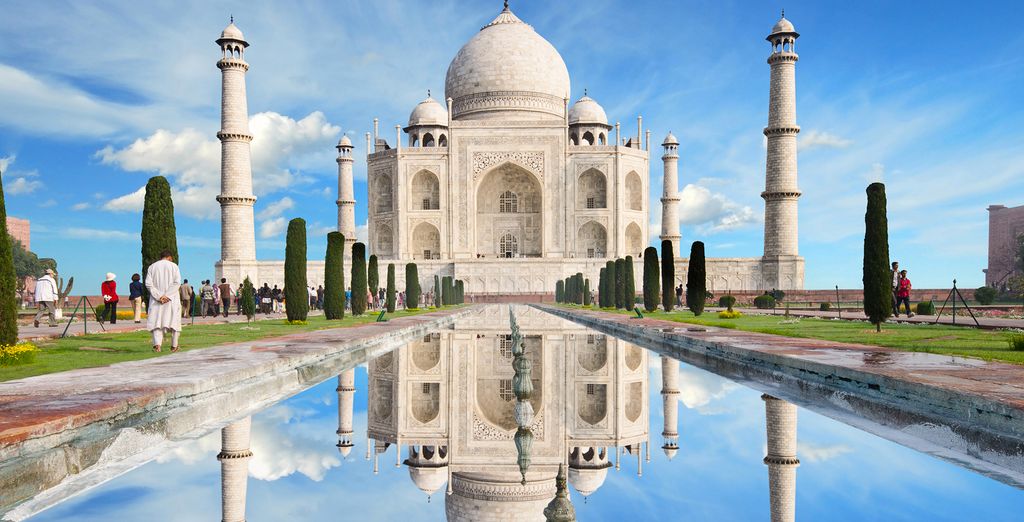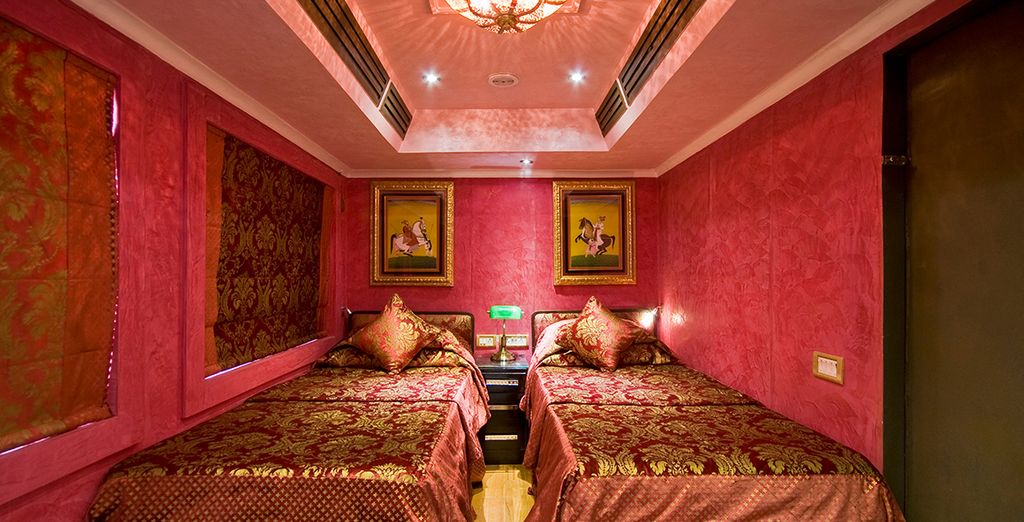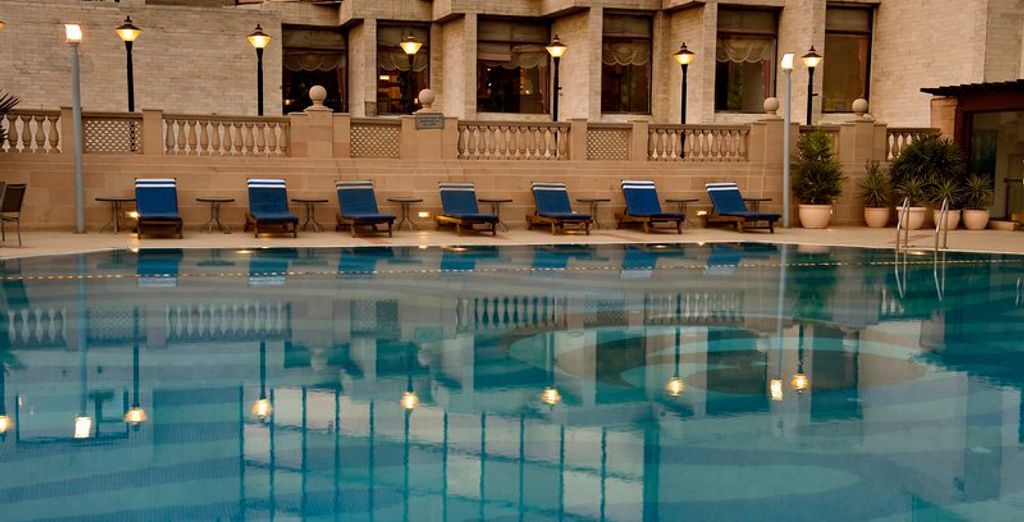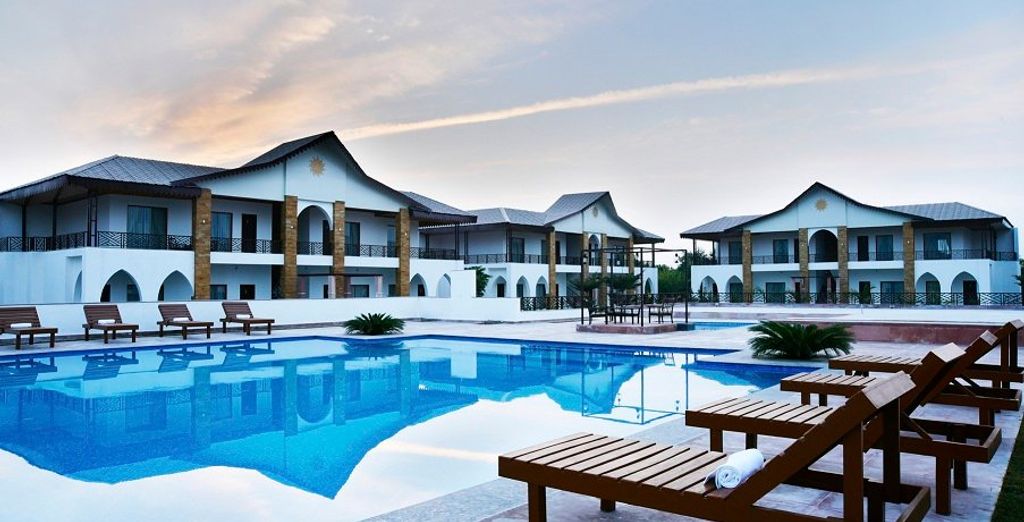

Visit Taj Mahal
Visit Taj Mahal in Agra, India : All you need to know ✅ Advice, Accomodation option, Prices... Exclusive offers up to -70% off ⭐.
Visit the Taj Mahal in Agra
This beautiful white marble structure is famed as being one of the best known symbols of tragic yet romantic love in the world. The Taj is a mausoleum, which means 'a stately or royal building housing a tomb or number of tombs'. In this case, the mausoleum is the eternal resting place of two people: Mumtaz Mahal, for whom the Taj was erected and her husband whose love for his deceased wife led him to spend what would, in equivalent terms today, be almost one billion US dollars to memorialise her.
Taj Mahal: All You Need to Know Before You Visit
1. What's in a Name?

The name of the Taj translates to 'Crown of Palaces'. Sharp-eyed readers will have noticed that the queen's name contains the word 'mahal'. She was awarded that name by her husband: Shah Jahan, declared that his bride, born Arjumand Banu, should be called Mumtaz Mahal Begum, which means 'the exalted one of the palace', and so it was. Shah Jahan, in keeping with a man of his status and wealth, had other wives, but was so very much in love with Mumtaz that he more or less neglected them, devoting much of his time and affection to his beloved. She often intervened on behalf of poor people, persuading her husband to take an interest or behave with more kindness than he might otherwise have done, and he, in turn, appreciated her input in matters of state. Their union was fruitful, producing fourteen children, of whom only half lived to adulthood. However, the fourteenth pregnancy proved too much for Mumtaz, who died from post-partum haemorrhage.
2. It Was Not a Quick Build
The building of the Taj took about twenty-two years. Shah Jahan went into prolonged mourning for a year, and it took intervention from his eldest and favourite daughter to encourage him back out into the world. His interest was piqued by a military manoeuvre, but even as he was conducting his troops and working out tactics, in the back of his mind he was planning a monument fit for his dearly beloved queen
3. It Is Meant to Be Hers Alone

Shah Jahan designed and commissioned the Taj as a monument to his wife, and it was meant to only hold her body. However, when he died, his son – who had helped to move his mother's body from her first temporary burial site shortly after her death – had his father's tomb placed next to hers, so they could be together forever. This is made poignantly clear when one realises that every single aspect of the building, inside and out, is perfectly symmetrical except for one thing: Shah Jahan's sarcophagus, which is placed to the side of Mumtaz's, hers being placed in the exact centre of the room. One wonders what the Shah would make of it: would he be displeased that the lines of symmetry have been disrupted, or would he be happy that he and his bride are together again?
4. It Is a Marvel of Unity
The mausoleum has Persian touches, Hindu features, and also contains a mosque, as both Mumtaz and her husband were Muslim. The finial atop the dome features a crescent moon, long a symbol of Islam, turned slightly to provide a nod to the Hindu God, Shiva's, trident, showing the effortless blending of both their backgrounds and their shared life. The decorations all around the monument adhere to Islamic restrictions on anthropomorphic representations (no people or animals may be depicted) featuring, instead, plants, precious and semi-precious stones inlaid in exquisite patterns and the beautiful snowy white marble from which the whole building is constructed.
5. It Can Be Moody!
The Taj changes with the shifting sun: taking on a pink hue in the early morning light, glowing a softy milky white at sunset and exuding a soft golden hue in the moonlight. It is said that these changes mirror Mumtaz's moods in life.
6. The Building is Designed to Protect its Occupants
The building is dominated by a magnificent 'onion dome' under which the false tombs of the king and queen lie, with their real tombs being in the same place, just one level below. There are four smaller minarets dotted around the dome, and a careful observer will see that these are tilted ever so slightly away from the central dome. In this way, should an earthquake or other disaster strike, the minarets will fall away from the dome, rather than towards it, thereby preventing the tumbling minarets from harming the tombs
7. No Pollution Here, Please
When motor cars became cheap and readily available, it was noticed that the Taj's beautiful white marble exterior was beginning to yellow from the fumes and contaminants in the air. A boundary was established, inside of which no diesel or petrol cars are allowed, while some electric cars are tolerated. This zero tolerance policy has worked and the building has been returned to its pristine white beauty.
8. There Should Have Been Another Taj – Or Should There?
There is a long-standing tale that Shah Jahan planned his own tomb to be a mirror image, albeit in black marble, of his wife's. He was clearing land, so the legend goes, to build the tomb, when he was deposed by his own son, being killed before he had the chance to bring these plans to fruition. The truth of the matter is that the tale of the Black Taj was invented by Jean-Baptiste Tavernier who saw the Taj in 1665, shortly after its completion: there is no mention of it before his writings, although the rumour has remained persistently in folk-lore. However, when the reflecting pool in the grounds of the Taj was cleaned and restored to its former glory in 2006. From a certain position, the entire Taj is reflected darkly upon the surface of the water providing a superb symmetry that can only have been part of Shah Jahan's plan, so perfectly do the reflections line up, especially when there is no wind and the surface of the water is unblemished.
Discovering India: Where to Stay
1. Palace on Wheels Train Tour

The Indian countryside is so beautiful and so vast that it is almost impossible to see more than a tiny piece of it with each holiday visit. However, an excellent and stress-free way to maximise your enjoyment is by touring through the country by train. The package includes all your accommodations and meals as ensures that there are plenty of stops along the way so you can sample the best Indian features as you travel in sumptuous style in spacious bedrooms arrayed with silken linens, en suite bathroom, and the finest international standard cuisines. The train is beautifully decorated with comfortable and opulent furniture which makes it easy to understand why this vehicle is called a 'palace on wheels'.
2. Golden Triangle Tour with Gujarat

This magnificent monument is not India's only treasure: there is also Jaipur City Palace and Agra Fort, all fairly close together, especially the fort and the mausoleum, both of which are in Agra, a mere ten minute drive from the other, while Jaipur is about 250 kilometres away. This tour takes in all three sites, before heading to the wild splendour of Gujarat's Gir National Park where you can admire wild lions in their natural habitat: the only place in the world outside of Africa where this is possible. You will stay in a range of 4 and 5-star hotels as you travel, with plenty of time devoted to ensuring that you get to see and enjoy all the sites and sights along the way. NB: This tour does include some domestic flights.
3.Temples, Tigers and Taj Tour

Delhi, Jaipur and Agra are just three of the exciting and action-packed destinations on this fabulous tour that introduces you to India's best-known features, even as you are introduced to tigers in the wild, marvel at the wonders of the Taj and admire the awe-inspiring temple architecture before heading to your hotel for a night or two, enjoying world class cuisine, superbly comfortable rooms and world beating customer service.
Visiting Agra: Practical Information and Advice
What are the opening hours? When is the best time to visit?
The Taj is home to a functional mosque and as such the site is closed to tourist visitors on a Friday, which is Islam's holy day. If you do visit on a Friday, you will probably only be permitted to observe the outside of the building, and you will be asked to be respectful of those who are practising their religion. Muslim visitors will, of course, be welcomed into the service as they would at any mosque.
On every day other than Friday, visitors are welcomed into the Taj. There are a number of rules and regulations about the building, almost all to do with being protective of the marble and the artworks embedded within the walls. These include shoe-covers being necessary, no eating or drinking within, no tripods and no electricals aside from still cameras and silenced mobile phones, amongst many others.
Opening hours are, loosely, sunrise to sunset, with early morning visits being best for no crowds and pleasant temperatures. The Taj looks wonderful in full afternoon sun, but this is when the crowds and the sticky heat can be at their worst. Moonlight tours are available and offer a uniquely romantic perspective on the Taj, which is designed to allow light, whether from the moon or the sun, to flood into it.
Prices for entry to the Taj Mahal. How to buy tickets?
Children under the age of fifteen can enter the Taj for free, while tickets for foreign adults cost about 1,100 rupees. The cost to locals is much lower, a mere 40 rupees, to ensure that even the most modest earners can enjoy exploring this jewel of the country. An extra ticket, costing around 200 rupees must be purchased if you want to see the main mausoleum: this is in addition to the above costings. Tickets can be purchased online through the governmental website and through the local authority website, or on site starting one hour before sunrise until about 45 minutes before sunset.
Tips to avoid queues in Agra
Avoid weekends, public holidays, peak tourist season (if possible – but this can mean visiting in punishingly hot weather), and do aim to visit as early in the day as possible. Thursdays, oddly enough, are the monument's quietest day, so for a visit with as few other tourists as possible, plan to visit as early as possible on a Thursday! The site does receive around seven to eight million visitors per year, so 'quiet' is probably a fairly relative term.
Agra: How to Get There
Coming to India is achieved most often by plane, but can also be reached by ship, if you fancy a cruise to start your Indian odyssey. Once you have arrived, usually landing at one of the 28 or so international airports in the country, you can continue your journey in a smaller plane on a domestic flight, or you can hire a car to drive yourself. Trains and buses are also good solutions, getting you to Agra in good time.
Suggested visiting time – how long do you need?
You could probably while away an entire day taking in all the beautiful details and décor of the Taj, but as an absolute minimum, you can probably get a good sense of the site and see all the most important features in about two hours.
What souvenirs to buy?
This one is a no brainer: models, images, posters, magnets, coasters all featuring the Taj are ideal souvenirs to pick up to remind of your visit to Uttar Pradesh. For more up-market gifts, look for precious and semi-precious stones, but as always, try to find something that encapsulates your visit, something that will instantly remind you of India and bring a smile to your face.
Any precautions to take?
As with any visit to a religious building, be mindful of showing respect by dressing modestly, not touching any artefacts or exhibits and even speaking in reduced tones so as not to bother other visitors. Agra is, justifiably, proud of its wonderful monument and while they are very appreciative of the many tourists who bring a good income to the city, they frown upon any disrespectful behaviour, talk or treatment of the site. There is a security check at the door, and if there are any disallowed items you may have to trust your contraband to a hired locker just outside the gates. As this list includes electronics apart from cameras and mobiles, this could be an expensive proposition, so do try to carry only appropriate items with you.
